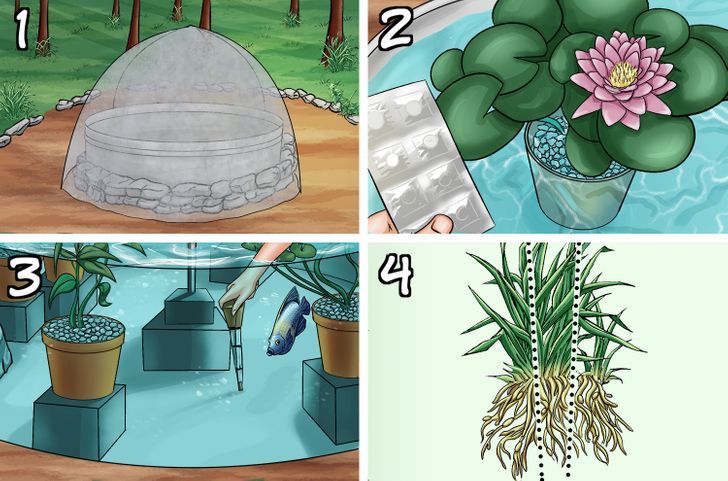How to Easily Build an Outdoor Waterfall Aquarium

A waterfall aquarium is a soothing decoration for your garden and having one is beneficial for your health too. 5-Minute Crafts wants to help make this win-win situation possible in the easiest way.
Things you’ll need to make a waterfall aquarium
- Stock tank (circular or oval and must be at least 2-feet-deep)
- Pickax for piercing the topsoil
- Shovel for digging up the ground
- Gravel rocks
- Paver base
- Spirit level
- Clean water
- Oxygenator plants like anacharis, cabomba, water lilies, etc.
- Marginal plants like dwarf papyrus, taro, etc.
- Deepwater plants like water lilies, lotus, etc.
- Aquatic plant fertilizer
- Cement blocks
- Fish (goldfish and native gambusia are the best choices)
- Water pump
Getting your stock tank ready

- Measure the area where you want the aquarium to be installed and ensure that it is a few feet larger than the size of your tank.
- Dig out the grass or groundcover and make it at least 3 inches deep.
- After digging, create a boundary around the hole with gravel rocks.
- Fill the hole with the paver base.
- Use a spirit level to make it stable and even, so that your tank doesn’t look tilted.
- Place the container tank on the even base and fill it with clean water, like rainwater, which is the purest form of water you can ever use.
- If you’re using tap water instead of rainwater, then let the water set in the tank for at least 3 to 4 days so that the chlorine in the water evaporates.
Getting the plants ready

- Put the plants in a bucket of water as soon as you bring them home from the market, while you prepare the pots to be kept in the pond.
- Use old plastic pots filled with clean pea gravel.
- Create a hole in the gravel with your fingers.
- Bank the stems of the plants carefully. Then bank the pea gravel around the plant.
- If the pots are too small for the pond, you can also create platforms by placing stacked bricks, overturned pots, and cement blocks in the pond. Save some space in the center for the pump.
- Keep the pots on the platforms.
- If you’re using water lilies, keep the pot on the bottom so that the leaves can reach the surface. If the leaves aren’t long, place them on a platform.
- Once a month during blooming season, around March to October, press a fertilizer tablet finger deep into the water lily pot.
- You can also use cement blocks with holes in the middle to give the fish a hiding place from predators.
Bird-bathing and insect-drinking platform

Put a stone bathing platform on top of the cement block, near the edge of the container pond.
- This step is optional, but since ponds are meant to be hospitable for birds, insects, and other small creatures for bathing or drinking water, having this platform is optimal.
Fish

- Before you buy fish, you may want to ask your supplier about the number of fish your container pond can support.
- Once the water in the pond has dechlorinated, let the container pond sit for a week, and then you can add the fish.
- Goldfish are always a good choice or you may also want to go for native gambusia, as they are mosquito-eating fish, to keep your pond bug free.
Pumps and filters

- Place the pump in the middle of the pond.
- If the pump is too small in height, use a platform like a brick to lift it up.
- Ensure that the upper part of the pump is always above the surface of the water.
- Connect the cord of the pump with the power source.
- If the cord is too far away from the power source, consider investing in a solar-powered pump with rechargeable batteries.
This is what your waterfall aquarium should look like.

Here is what the numbers denote in the aquarium diagram:
- Pots: Use ceramic pots with no holes.
- Pea gravel: Use pea gravel to weigh down the plant containers.
- Aquatic Plants: Plant suitable aquatic plants like water lilies, lotus, and other plants, as listed above.
- Bird-bathing rock: This is placed for the birds and insects to quench their thirst or take a bath.
- Fish: Fish also help in keeping away mosquitoes.
- Pump: The pump must be above the water’s surface.
-
The plants and fish may differ according to your setup.
Maintenance

- Net the aquarium during the fall and winters to keep the fallen leaves and debris away.
- Fertilize every month during the growing season (as mentioned above for water lilies) to not let the plants rot away or get eaten by tiny insects.
- Muck out the bottom every year to keep the water clean.
- Divide plants once a year to promote the regrowth of your favorite plants and avoid overcrowding.
Share This Article